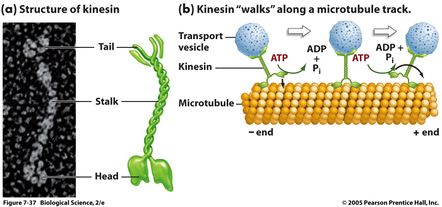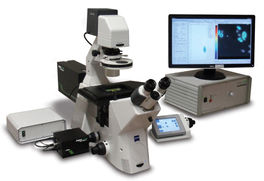Molecular motors
WOULD HAVE BEEN BETTER TO FOCUS ON CYTOSKELETAL MOTORS ONLY AS THE GENERAL AREA IS THE CYTOSKELETON. IT WOULD HAVE BEEN SHORTER AND MORE FOCUSED.
Definition and Brief explanation[edit | edit source]
Molecular motors are enzyme protein devices that move along cytoskeletal filaments and the proteins are run by ATP hydrolysis.
The main system of Biological motility is driven by the factor of intracellular motility. For example, the microtubules and the actin filaments in cells are tracks, and the molecular motors have two parts the tail domain that are carriers of cargo (organelle or protein) and the motor domain, which work along the track causing motion and thus causes movement. Molecular motors convert the chemical energy derived from ATP hydrolysis into mechanical action. Molecular motors are generally of 10-8 m sizeand are driven by the Hydrolysis of ATP and have an average speed of 4*10-3 m/hr
Varieties[edit | edit source]
Molecular Motors consist of different varieties
· Cytoskeletal – Kinesin, Dynein and Myosin motor groups. These are of large of groups and there are many motors from these groups.
· DNA Motors - Helicases and polymerases.
· Rotatory motors – Bacterial flagellum, ATPase
for example the aerobic respiration between the mitochondrial matrix and the membrane of the mitochondria.
The Medium it Drives on[edit | edit source]
The molecule motor drives on a Track.
The track is a polar structure and motors can go only in a unidirectional way
There are 2 types of general tracks in the cytoskeletal system
· Microtubules – Cylindrical Polymer and made of α and β tubulents.
o Mainly driven motors are Kinesin and Dynein
· Actin filaments – Helical polymer
o Mainly driven motor is Myosin
The Process[edit | edit source]
The actual motion as shown in the picture 2 follows a chemical cycle.
The Picture 3 is an example of muscle contraction of a Myosin motor on a actin filament.
This movement is the motor to bind on the actin track and slide the actin filament so that it can contract the sarcomere thus making a contraction.
Firstly in the animation you can see the myosin motor binding to the track and the actin filament causes a phosphate release and that causes a big rotation of 10nm of one part of the motor domain(highlighted red). Then the ATP comes in to the motor which causes the bonded motor to release from the track. Then the hydrolysis of ATP causes a movement or repositioning of motor domain in the actin filament. Thus, the cycle repeats again: the phosphate release and then a stroke, ATP hydrolysis occurs and reposting of motor.
Method of identification and development[edit | edit source]
Lots of methods are used to identify the movement, It is a very complex process and involves a lot isolation of materials – fluorescence imaging is one of the main technique used especially for the identification of mitotic filaments during mitosis. They use dyes to identify the motors and use energy transfer transition method to identify the molecular motors's movement and efficiency.
Optical tweezers and magnetic tweezers are also used in the developmental research of molecular motors. The optical tweezers is also an efficient method in the identification or it is otherwise called single-beam gradient force trap. as it says they make a trap in which the molecular motor action is perceived and identified.
Relevance in Medicine[edit | edit source]
Motor-based transport is essential to ensure efficient cargo delivery. Therefore it is not a surprising fact that most of the defects in motor-dependent transport are associated with a large range of diseases, including neurodegeneration, tumorigenesis and developmental defects.
It is used in medicine mostly by neuroscientist and neurologists
There are also a lot of pragmatic benefits by the study of molecular motors
· The study helps in identifying defects in molecular motor and pathways which are associated with neurological disorders or birth defects
· Also Drugs are also produced which either inhibits or enhances the work of molecular proteins in the tracks thus affecting the motility.
In Conclusion molecular motors are still being researched heavily as the main cause of motility are molecular motors and disorders and syndromes are mainly associated with the working of molecular motors hence different drugs are created to enhance the systematic efficiency. Also Scientist are continuously working on better models of the molecular motor proteins to get a more clear picture of the mechanism of these motors.
References[edit | edit source]
- Ron Vale: cytoskeletal motor proteins- http://www.ibiology.org/ibioseminars/cell-biology/ron-vale-part-1.html
- Cytoskeleton and Motor Proteins - http://www.tocris.com/pharmacologicalBrowser.php?ItemId=187904#.VlI0xd-rQza
- An introduction to molecular motors -http://thegrantlab.org/resources/handout_motors_CSUSM_11.pdf
- Figure 1 – Biological science, 2/e, 2005 Pearson Prentice hall, inc
- Figure 2 – Unknown author, https://media.giphy.com/media/UfU9efulhUK2s/giphy.gi
- Figure 3 - Ron Vale
- Figure 4 - http://www.directindustry.com/prod/lambert-instruments/product-20224-95346.html





